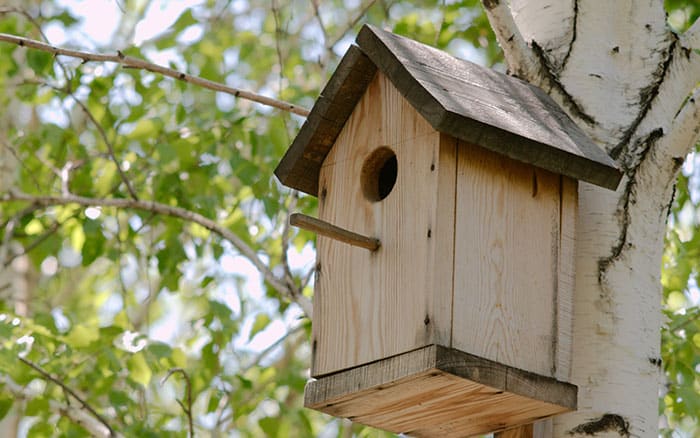Encouraging wildlife into your garden can have a really positive impact on both your garden’s eco system and the natural pest control it provides.
But once you get the birds into your garden, you want to make sure you help them, as they help you. Here’s how you can encourage different species into your garden and how to care for them, particularly over the colder months.
Nesting
WHICH BIRD BOX SHOULD I USE?
Classic style bird box
A classic style bird box is made of wood and has a slanted roof to help the water run off. You can buy slightly different sized ones, the main difference being that the hole in the front is available in different diameters.
25mm for blue, coal and marsh tits
28mm for great tits, tree sparrows and pied flycatchers
32mm for house sparrows and nuthatches
45mm for starlings
These bird boxes also have a little hole in the back to enable you to hang it easily to the surface you choose.

Open front bird box
Open front bird boxes are also available for birds that like to build their nests in open spaces, such as the robin or wren. These usually have half a front so that they still have somewhere to hide behind should they want to.
100mm high for robin
140mm high for wren

It’s important that between the months of January and August, you avoid checking the box. I know it’s tempting, but you will disturb the birds and potentially scare them off from their eggs, so try to enjoy from a distance. If you really want to see what the birds are up to – you can purchase a camera that fixes to the inside of the box and streams to your laptop or TV, so you can see what they’re up to!
Positioning

The position of the nestbox is just as important as the style. Here are some top tips for positioning.
• You want to pick a relatively sheltered position to avoid strong winds and heavy rain. On a tree that’s surrounded by other trees or on the side of a house are good positions
• Cats are climbers, and they will be able to get to bird boxes if it’s in an easy position for them. Make sure it’s not accessible to cats, or squirrels!
• Nest boxes with small holes are best placed between two and four metres off the ground, but you want to be careful that the entrance isn’t, or won’t be blocked by foliage.
• Nest boxes that are open at the front should be placed hidden from view, so a wall that has a shrub against it is ideal.
Cleaning and care
After the nesting season, you can clean out your nestbox to prepare for its next visitors.
Legally, you can only clean out nestboxes between 1st August and 31st January, if there are any eggs leftover after 1st August, it means that they have been unsuccessful this time. You should promptly destroy any of the eggs and it’s illegal to keep or sell them.

When cleaning out your bird boxes, wear gloves and clear out all the leftover materials. Pop this in a plastic bag and dispose properly. You won’t be able to use any of the materials to compost as they may be harvesting fungi or harmful bacteria.
Once cleared out, you can use boiling water and brush and scrub the inside of the box, don’t use any chemicals or detergents and make sure the box is completely dried out before replacing the lid.
Food and water

Food for birds will be sparse over the winter months, so it’s down to us to ensure that the birds that visit our garden are well fed and watered. Put out high calorie and fatty bird foods like fat balls of suet blocks alongside regular bird seed to help them get the energy boost.
There are loads of different types of feeders too, here’s a brief outline of the two most popular:
Ground feeders: this benefits birds that prefer to feed off the floor such as blackbirds, thrushes, wrens and robins. You can just scatter food on the patio, but this may get larger birds such as pigeons eating all the food, so you can get a feeder protector cage to give the smaller birds a chance.
Seed feeders: Seed feeders hang from trees and come in lots of different sizes and styles. You can fill these with bought bird feed or a mix of your own. These feeders are good for sparrows, tits, finches and siskins.
Always leave out a small bowl of fresh water too. Natural water sources may freeze over in this cold weather, so leave out a small bowl of water, or top up your bird bath. Birds will appreciate being able to drink it but also bathe and clean themselves.
By placing a small ping-pong ball or tennis ball in a full birdbath and letting it bob around in the wind, the water will keep moving enough to prevent it from freezing.

I’m so glad I came across this post David! I have been wanting to help to set up a bird house in my garden for awhile now and this has given me lots of information to get started. Thanks